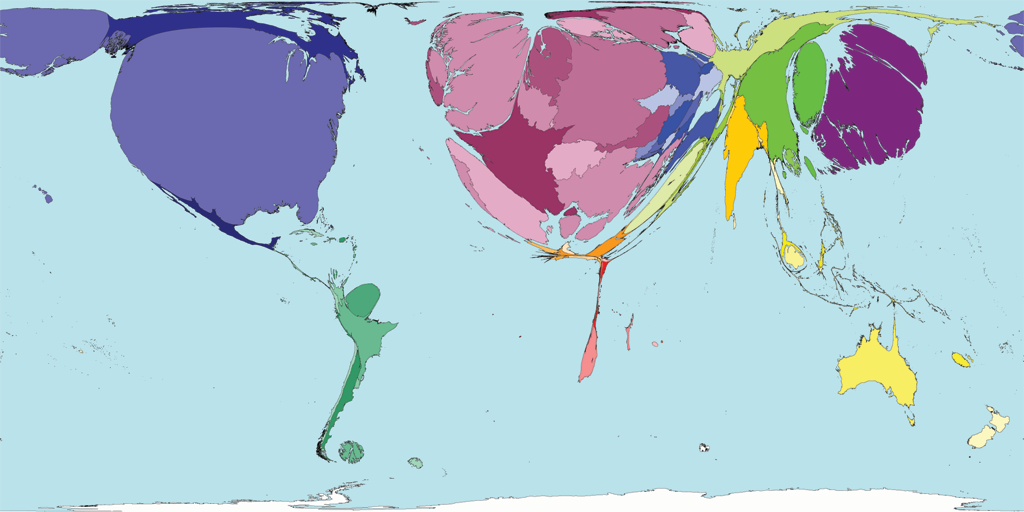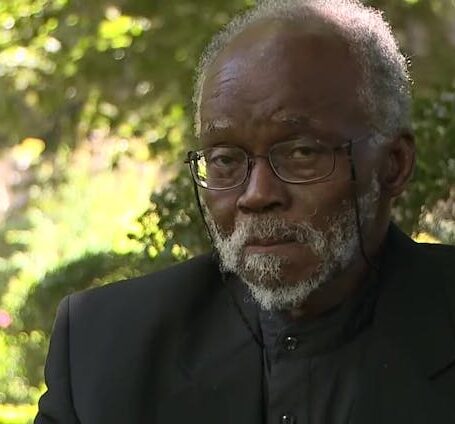This Global Science Map Is Not Destiny

From WorldMapper.org Click to enlarge
Showing “The World of Science,” the map above portrays global research production as expressed through science journals’ publishing in the early 2000s. It makes a dramatic point about the complexities of global inequalities in knowledge production and exchange. What would it take to redraw the knowledge production map to realize a vision of a more equitable and accurate world of knowledge?
Disparities
Knowledge creation and dissemination are, of course, crucially shaped by the practicalities of money and technology. It is significant that the average R& D intensity (R&D as a percentage of GDP) for OECD countries was 2.4 percent in 2009, while few developing countries had reached 1 percent (Mjwara et al 2013). These percentages of national funds are important differentiators in what is possible; without comparable levels of support researchers in resource-poor environments must spend inordinate amounts of time fundraising and dealing with external grant-giving organizations, are limited in their ability to participate in scholarly community activities, and so are often constrained in the research they can undertake. Infrastructure also shapes what is possible; for example maps of internet cable clearly show how collaboration between those in the global north is enabled by substantial bandwidth while north-south and south-south connections are not.

This article by Laura Czerniewicz originally appeared on the LSE Impact of Social Sciences blog as “Inequitable power dynamics of global knowledge production and exchange must be confronted head on” and is reposted under the Creative Commons license (CC BY 3.0).
Values and practices
These technical, financial and even mechanical issues are easy to identify, and so it is tempting to put one’s faith in the idea that more money and machines will solve the problems of knowledge production inequality. Values and practices – which legitimate certain interests and not others – contribute just as much to global imbalances as material disparities do. The positioning of these science journals is not neutral: engagement with them is characterized by several levels of uneven participation. They operate within a discourse in which “international” really means “global north.” This paradigm is reinforced by the strong reliance on the ISI Impact Factor, leading to an anomalous situation in which researchers from the global south must tailor their research to be of interest to high impact journals serving a northern research agenda.
For example, a study of four high impact journals in the management social sciences found that they attracted authors from many countries but their empirical sites of investigation were significantly located in Europe and North America (Hamman, R. Balancing the academic terms of trade: The paradox of publishing in top-tier journals from the periphery. unpublished, available from author). This indicates the extent to which local researchers will use their scarce resources to achieve publication in the high impact journals, supposedly international. Given the overall constrained research environments in which these researchers operate, these resources are lost to local research needs, and may in effect subsidize the research of the global north. Ironically, at the same time, relatively well resourced researchers from the global north undertake research in developing countries and publish in those same “international” journals. In the worst cases, the global south simply provides novel empirical sites, and local academics may not become equal partners in these projects about their own contexts.
Researchers in the global south are caught in a double bind. They are rewarded for publishing in international journals in several ways: through promotions, and sometimes even financially (in South Africa, for example, universities receive about $13,000 from the National Department of Higher Education and Training for every article published on accredited lists ( and in 21 of the 23 universities a percentage of this “reward” goes directly to the authors). At the same time, development imperatives and government policies pressurize researchers to undertake research relevant to pressing social and related problems which may not be appealing enough (or even “academic” enough) to interest the international journals. One scholar thus noted wryly that, “African scholars face a critical choice between sacrificing relevance for recognition, or recognition for relevance” (Nyamnjoh 2010, p.69).
Another problem not captured by the journals map is that it measures science journal articles as the sole representation of scientific research output, whereas there are other valid forms of outputs which also report research findings. Obvious examples in the scholarly community are monographs and edited collections. While the map portrays science research, it interprets this narrowly, and fails to include the social sciences and humanities which continue to value books in all forms, both digital and in hard copy.
Also, in many contexts valid research is undertaken and published with the unfortunate name of “grey literature’- in the form of working papers, technical reports, policy reports, etc. These genres of research output are often prevalent in research areas focused on pressing development issues. In South Africa it is instructive to consider, for example, the outputs of research organizations such as PLAAS (Programme for Land and Agrarian Studies) and SALDRU (South African Labour Development Research Unit), whose prolific, robust and internationally- recognized output would be poorly reflected on the map above. The usual rejoinder to the inclusion of such research is the question of quality; but the answer lies not in rejecting these forms of outputs but in finding ways to prove their worth whether through new mechanisms of peer review, or through new metrics which measure impact and value through use and re-use, not just citations in the same coterie of journals from which many are excluded in the first place.
Another category of “invisible research” from the South is the considerable output commissioned by government and undertaken by consultants, many of whom are practicing academics. Even when published, this kind of research is often not attributed to its actual authors. It has the added problem of often being embargoed, with researchers even having to sign confidentiality agreements or “official secrets acts” when they are given grants. This is especially bizarre in an era where the mantra of publicly funded research being made available to the public has become increasingly accepted.
From access to participation
Yet another snag that is surfaced in the knowledge outputs represented in the map above is that they generally reside behind paywalls and can only be reached by people with access to expensive academic databases. This excludes those who cannot afford to pay for it, i.e., researchers in resource-constrained environments, and members of the general public who do not have passwords for the electronic facilities of universities and research institutions. Of course this situation is about to change substantially as the open access policies that are currently percolating in the system in the EU, the UK and other countries are implemented over the next few years. This will substantially increase the volume of research to which scholars and readers all over the world have access, and will undoubtedly be a very important contribution to research. Ironically, however, the danger of this more ubiquitous availability is that without similar national and regional policies in the developing world, and without resources being made available to actively support open dissemination in these countries, many types of research from the developing world will be rendered even more invisible. This may unwittingly consolidate the erroneous impression that these scholars are undertaking little of value, have little to contribute to global knowledge and are reliant on the intellectual capacity of the global north.
In conclusion, to redraw the map of global knowledge production, the inequitable global power dynamics of global knowledge production and exchange must be confronted head on. Funding and infrastructure must be improved, our perceptions of “science” must be broadened to encompass the social sciences, research outputs need to be recognized as existing beyond the boundaries of the formal journal article, incentives and reward systems need to be adjusted to encourage the legitimation of the new fairer practices more possible by the affordances of a digitally networked world. And finally, the open access movement needs to broaden its focus from access to knowledge to full participation in knowledge creation and in scholarly communication.































































































